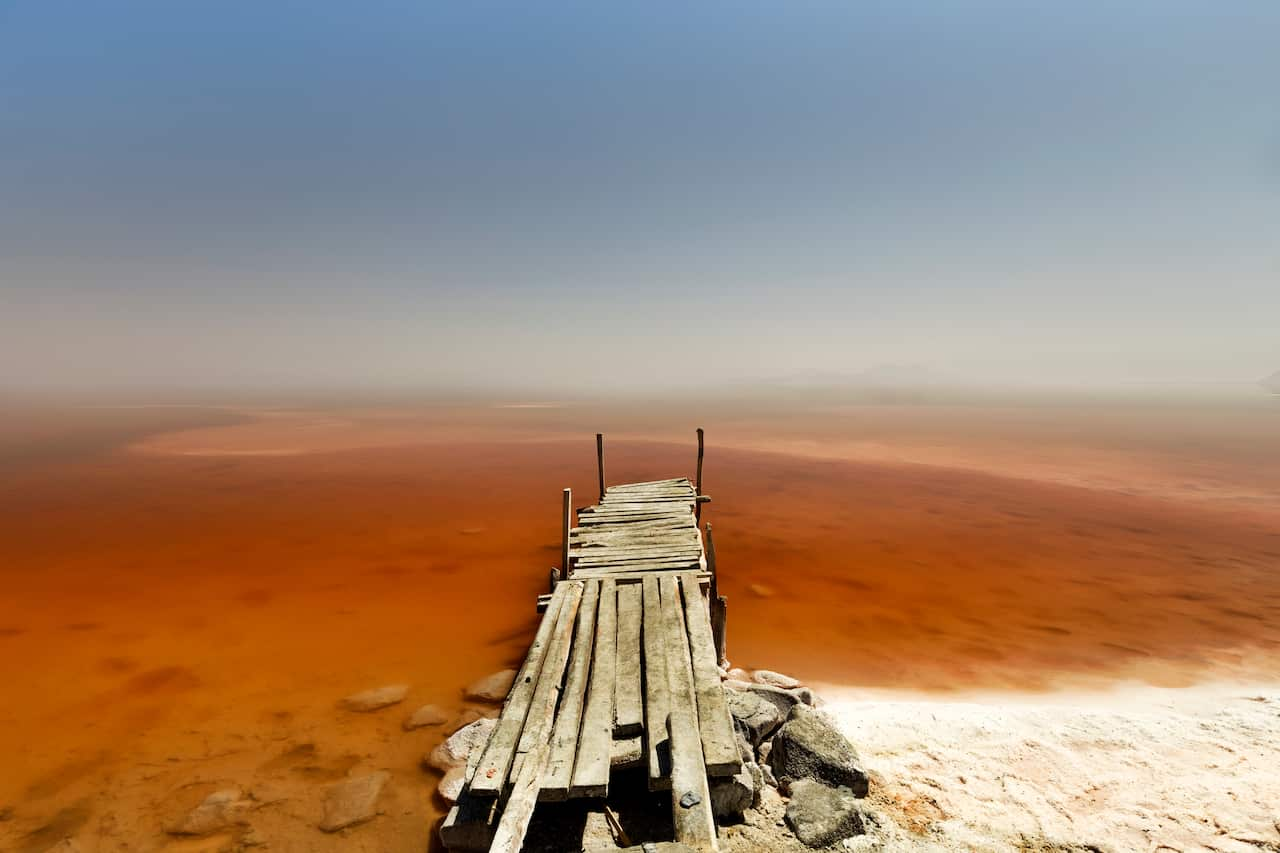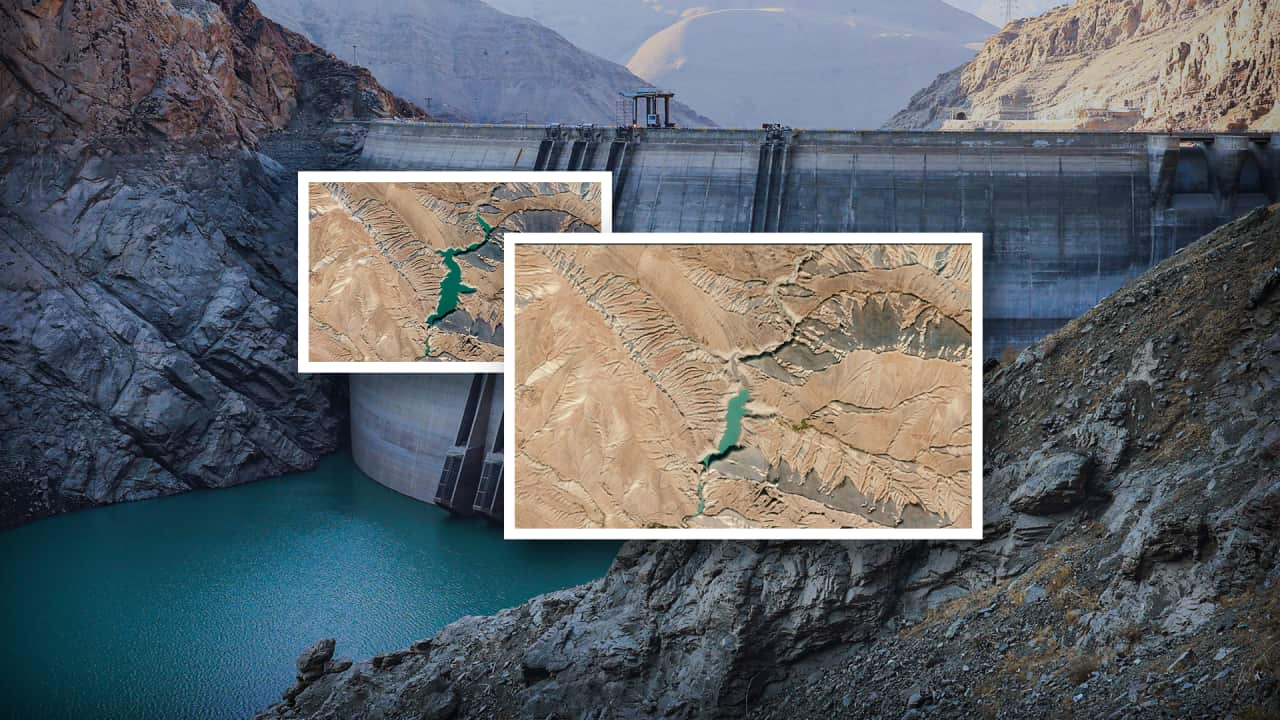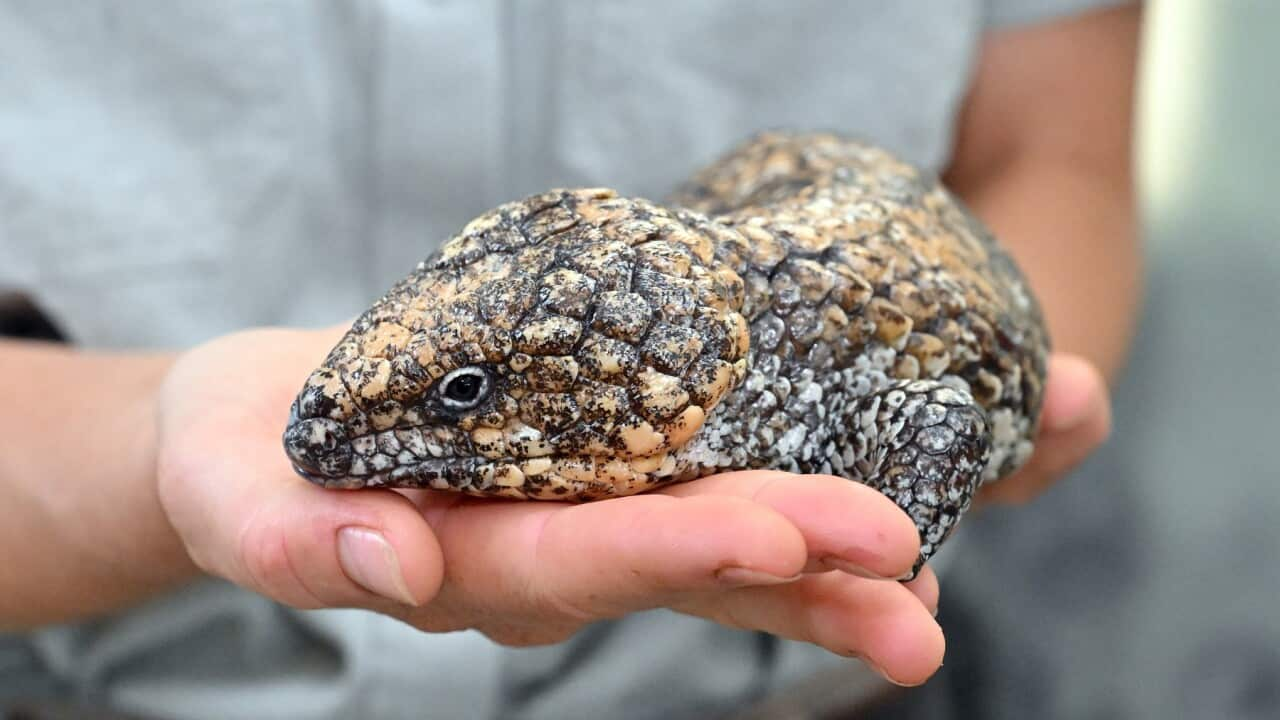Each night after work, Shervin returns to his apartment in the centre of Iran’s capital, Tehran, hoping for a shower and a clean change of clothes.
But over the last week, turning on the tap has become like playing Russian roulette — some nights, not a single drop flows out.
“For some time now, we have been having a problem with water pressure. The tanks we keep in the building would run low on water during the day because of the weak pressure,” he tells SBS News.
“But now the issue has gone beyond water pressure, and the water is cut off at night, causing the [tanks] to empty out.”
SBS News has changed Shervin’s name due to concerns over potential backlash from the Iranian regime.
Tehran’s main water sources are in a dire situation. Latian Dam is at less than 10 per cent capacity, and nearby Karaj Dam, which supplies both Tehran and Alborz provinces, has also reached what officials call “dead capacity”. Source: EPA, AAP / Abedin Taherkenareh
Shervin is one of nearly 15 million people currently facing a severe water shortage in Tehran province in what has become a very dry autumn. Across Iran, there has been record-low rainfall, and many of the main reservoirs are almost dry.
Officials have warned the country is now experiencing an unprecedented water crisis, the scale of which has not been seen in about six decades.
According to the latest data from Iran’s energy ministry, the volume of water entering the country’s reservoirs has decreased by 53 per cent compared to last year.
Some Iranian water officials have described Tehran’s surface water levels as “critical and extremely fragile”.
‘Losing the possibility’ to live in your home
The crisis is now being felt by everyday Iranians, particularly those in Tehran.
“We had experienced [water shortages] before, but I don’t think we felt this much danger,” Shervin says.
Some local officials have suggested they may need to reduce water pressure from late at night to early morning to manage demand and save resources.
But citizens, like Shervin, are reporting that they already lack complete access to water in their homes for certain hours of the night, and are resorting to storing it in empty bottles “to at least maintain some hygiene at night”.
Ali Nazari, another Tehrani resident and a writer, tells SBS News he finds “stored-up water bottles stacked in a corner” in every house he visits.
He blames government mismanagement for the situation.
“This is no longer a political issue … The issue is that they have deprived us of the basic necessities of life,” Nazari says.
We are losing the possibility of living in our own city, in our own home, in our own country.
“Despite all these hardships, people endured and tried to keep life going, because, after all, humans live on hope.”
Some Iranian officials have blamed the water shortage on the recent drop in rainfall.
“We kept telling ourselves, It’ll get better, it’ll get better. But the water crisis is no longer something that hope alone can fix,” Nazari says.
“You turn on the tap and there’s no water. You have to experience that to understand how terrifying it is, how essential water is to your life, and how everything just stops without it.”
‘I feel miserable’
Many Iranians have not been surprised by the situation, as numerous scientists and politicians have warned for decades about the repercussions of water scarcity in Iran.
Around a decade ago, Isa Kalantari, a former agriculture minister and head of Iran’s environment department, warned that if water management didn’t change, 50 million Iranians would have to migrate.
Kaveh Madani, director of the United Nations University Institute for Water, Environment and Health, also warned of this situation back in the early 2000s.
Later, while serving as Iran’s deputy environment minister from 2017 to 2018, he raised serious concerns about the worsening water shortage and criticised the regime’s water management. In response, he was accused of being a “water terrorist” by Keyhan Newspaper, which has links to Iran’s Supreme Leader Ayatollah Ali Khamenei.
Over the last few years, environmental activists have been reportedly targeted in Iran by authorities; some have been subject to arrest, imprisonment, torture and charges, including accusations of espionage.
Human rights groups say such punitive actions are an attempt to silence critics.
In 2018, Kavous Seyed-Emami, a prominent Canadian Iranian environmentalist, was found dead in Iran’s Evin prison. At the time, Iran’s judiciary claimed he killed himself in detention after seeing evidence against him in a spying case. His family and many international rights groups have rejected this claim, demanding an independent investigation.
Seyed-Emami was arrested with seven other members of the Persian Wildlife Heritage Foundation. Other members of this group were charged with ‘corruption on earth’, which carries the death penalty, though this charge was eventually reduced.
After spending several years in prison, they have since been released.
During his term as deputy environment minister, in 2018, Madani was accused of being a Western spy and subsequently resigned from his governmental position. He has lived in exile for the past seven years and, speaking with SBS News, expressed dismay that his predictions are proving correct.
“I feel miserable,” he says.
“There are two things I care about as an Iranian. I care about my land, Iran, its nature, and the environment, and then I care about the people of Iran. And if they’re suffering, there is nothing to be proud of.
“I don’t care if those projections or predictions are correct.”
Tehran on the brink of ‘day zero’
Madani describes the situation in Iran as “totally unprecedented”, noting Tehran, “the richest and most populous city”, is only a few days away from running out of water.
“When water is short, you always first cut from the environment. That’s the silent stakeholder. Then water shortages affect the farmers, then the industry, and the last affected group are the residents of the urban area,” he says.
“The fact that this issue has now reached Tehran, Tehran is talking about day zero, the day that the taps would be dry, means that we are in the worst possible situation.”
‘Day zero’ is the point at which residential taps are turned off and water is redirected to local collection points — a clear sign that a city is almost out of water.
Data from the Iran Water Resources Management Company indicates Iran’s water reservoirs are in a critical state. In Tehran, the main water resource dams are operating at levels 40 to 85 per cent lower than last year.
Local officials have stated the Karaj dam near Tehran has reached its “dead capacity”, meaning most of the water in the reservoir is uncollectable.
More than 60 per cent of the water in Tehran is supplied by underground sources, which many experts warn are also dwindling.
A 2024 study shows Tehran has one of the country’s largest groundwater depletions — meaning groundwater is extracted faster than it can be naturally replenished — with approximately 101 million cubic metres of groundwater extracted annually. The clouds aren’t helping either, as Tehran hasn’t received any rain during its autumn, which spans September through November. Typically, the city gets about 30mm of rain in the same period, according to officials.
The city, famous for its surrounding snowy mountains, hasn’t seen a drop of rain in over 200 days.
Residents considering leaving
Iran’s President Masoud Pezeshkian has warned if it doesn’t rain in Tehran, they will start rationing water; if that doesn’t work, “we must evacuate Tehran”.
Some Tehranis, like Mohammad and his family, are already considering leaving their hometown.
SBS News has changed Mohammad’s name for security reasons.
“If this situation continues, we will have to leave this city and relocate to a place with access to water,” he tells SBS News.
“[Moving] is definitely challenging. But every person is more concerned with their survival than with the city they live in.
“At least the basic facilities of a normal life should exist.”
Shervin echoes this sentiment, saying if the shortage grows, there will be “no other option but to leave the province”.
Madani says no-one knows exactly when all the water resources will be exhausted, but he projects it’s not too far away.
“What we can see from the satellites is that most of those reservoirs available around Tehran are out of storage, out of water,” he says.
This is something we have not seen before.
“This is no longer a crisis … At least when a crisis occurs, we have some hope that mitigation is possible. This is a point of failure,” Madani says.
Behind Iran’s ‘water bankruptcy’
In his research, Madani uses the term “water bankruptcy” to describe the water shortage in Iran.
He uses the analogy of a bank account when speaking about water management, likening surface water to everyday funds stored in a ‘deposit account’ and used up first.
The expression ‘saving for a rainy day’ comes in here. Madani says the savings account, which is the country’s groundwater and has been built up over generations, is then used as a last resort.
When the underground water runs out, the bankruptcy starts.
“Now we have a lot of users and water rights holders who cannot receive their water,” he says.
The consequences of this have unfolded in various parts of Iran that are facing environmental issues such as “shrinking lakes, land subsidence, sinkholes, desertification, deforestation, sand and dust storms and wildfires, biodiversity loss, and many things that are related to shrinking water resources”, Madani explains.
In 2016, a joint research program between the University of Melbourne and Sharif University of Technology in Iran focused on finding solutions to save Lake Urmia. Source: Getty / Westend61
Experts say the shrinking of Lake Urmia in north-western Iran — the country’s largest lake — months ago, highlights Iran’s environmental and water issues, as well as government mismanagement.
“The water development in Iran actually can be very well compared with parts of Australia and the US … In some parts of the world, soon after implementing big projects like building dams, digging deeper wells and building more desalination plants … We learned that this model is not sustainable,” Madani says.
“It’s backfiring because the more you bring water, the more you promote the perception of water availability.”
Yet Iran has seen those symptoms of the problem, has seen the environmental damages, but did not change.
“The water bankruptcy situation in Iran is the product of years of mismanagement, lack of foresight and over-reliance on technology, dismissing the fact that water can be a limit to growth, exacerbated by a long drought and climate change,” Madani says.
SBS News put questions to Iran’s energy ministry about its water management policies, but did not receive a response by the deadline.
Previously, during another water shortage period in July, Pezeshkian accepted that the “previous decisions were wrong”.
“If we continue to develop without a plan, without knowing what the future will be like, we will not be able to respond to future generations,” he said.
Climate Change and ‘the billion dollar question’
Recent research has shown that climate change is fuelling and will continue to fuel droughts in the Middle East and North Africa (MENA) region.
In 2023, a rapid attribution analysis by the World Weather Attribution service showed high temperatures caused by climate change are driving an ongoing drought in the Middle East.
Madani cautions against solely attributing the current drought in Iran to climate change but says more generally, “climate change is making droughts more frequent and more intense in many parts of the world, including the Middle East”.
In 2023, UN experts from the Intergovernmental Panel on Climate Change projected that for every one-degree increase in the global average temperature, renewable water resources would drop by 20 per cent.
With the global climate summit underway in Brazil, some campaigning organisations, such as Greenpeace, are calling on COP30 members to also focus on the MENA region, which is “standing on the frontlines of the climate crisis”.
Quentin Grafton, professor of economics and convenor of the Water Justice Hub at the Australian National University, says some MENA countries, especially those with large and growing populations, are struggling to keep up with the demand for freshwater resources.
“The situation is dire. It depends on the country, but if you look at North Africa, there’s very little surface flow. There’s groundwater, but that groundwater is being used up rapidly,” he tells SBS News.
Water scarcity is of growing concern, with experts warning it could lead to further tension in the region.
“That’s the billion-dollar question. Certainly, there has been conflict,” Grafton says.
“You’ve got countries in the Middle East that do have sources of water, particularly in the mountains … But there [are] conflicts around how that water is going to be allocated across countries and within those countries.”
Grafton says these challenges are not isolated to MENA and that many countries around the world, including Australia, are likely to experience water scarcity in the future.
“It’s a challenge, but again, it’s not unique to the Middle East and North Africa. We have our own challenges in Australia.
“It’s not like we should be pressing a panic button, but we should be worried. We need to be planning.
“We have to do it now in Australia, and they have to do it now in the Middle East and North Africa.”








